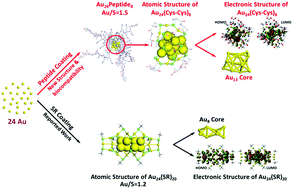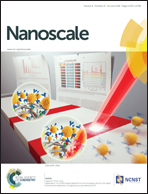Atomic structure of a peptide coated gold nanocluster identified using theoretical and experimental studies†
Abstract
Peptide coated gold nanoclusters (AuNCs) have a precise molecular formula and atomic structure, which are critical for their unique applications in targeting specific proteins either for protein analysis or drug design. To date, a study of the crystal structure of peptide coated AuNCs is absent primarily due to the difficulty of obtaining their crystalline phases in an experiment. Here we study a typical peptide coated AuNC (Au24Peptide8, Peptide = H2N-CCYKKKKQAGDV-COOH, Anal. Chem., 2015, 87, 2546) to figure out its atomic structure and electronic structure using a theoretical method for the first time. In this work, we identify the explicit configuration of the essential structure of Au24Peptide8, Au24(Cys–Cys)8, using density functional theory (DFT) computations and optical spectroscopic experiments, where Cys denotes cysteine without H bonded to S. As the first multidentate ligand binding AuNC, Au24(Cys–Cys)8 is characterized as a distorted Au13 core with Oh symmetry covered by two Au(Cys–Cys) and three Au3(Cys–Cys)2 staple motifs in its atomic structure. The most stable configuration of Au24(Cys–Cys)8 is confirmed by comparing its UV-vis absorption spectrum from time-dependent density-functional theory (TDDFT) calculations with optical absorption measurements, and these results are consistent with each other. Furthermore, we carry out frontier molecular orbital (FMO) calculations to elucidate that the electronic structure of Au24(Cys–Cys)8 is different from that of Au24(SR)20 as they have a different Au/S ratio, where SR represents alkylthiolate. Importantly, the different ligand coatings, Cys–Cys and SR, in Au24(Cys–Cys)8 and Au24(SR)20 cause the different Au/S ratios in the coated Au24. The reason is that the Au/S ratio is crucial in determining the size of the Au core of the ligand protected AuNC, and the size of the Au core corresponds to a specific electronic structure. By the adjustment of ligand coatings from alkylthiolate to peptide, the Au/S ratio could be controlled to generate different AuNCs with versatile electronic structures, optical properties and reaction stabilities. Therefore, we propose a universal approach to obtain a specific Au/S ratio of ligand coated AuNCs by adjusting the ligand composition, thus controlling the chemicophysical properties of AuNCs with ultimately the same number of Au atoms.


 Please wait while we load your content...
Please wait while we load your content...